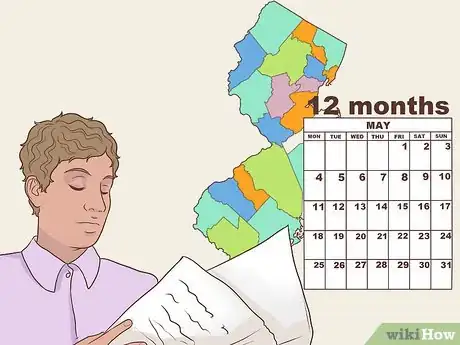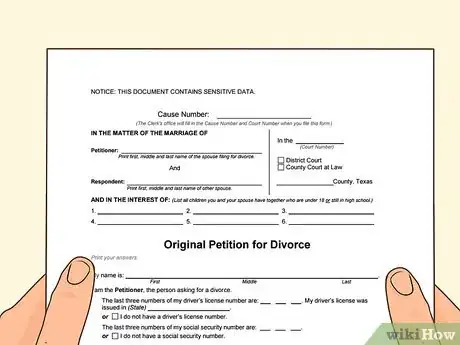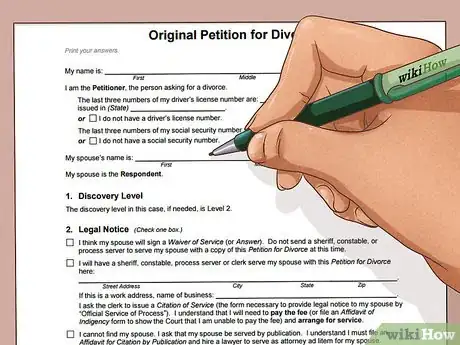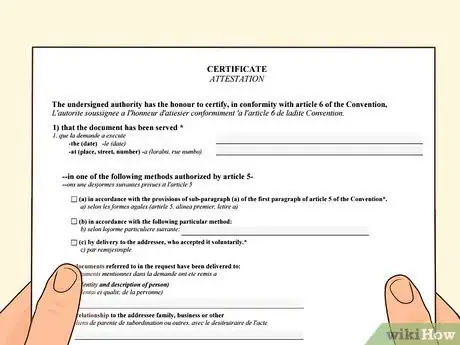This article was co-authored by Clinton M. Sandvick, JD, PhD. Clinton M. Sandvick worked as a civil litigator in California for over 7 years. He received his JD from the University of Wisconsin-Madison in 1998 and his PhD in American History from the University of Oregon in 2013.
There are 14 references cited in this article, which can be found at the bottom of the page.
This article has been viewed 52,930 times.
When divorcing a spouse who lives outside the U.S., providing proper notice of the divorce is critical. First, you must find a court that can legally issue a divorce decree. This generally will be the court in the county where you live. Second, you must serve notice of the divorce proceeding on your spouse who is outside the United States. It is entirely possible to divorce a spouse who lives in a foreign country, though you might have difficulty if you want child custody or alimony as part of the divorce.
Steps
Getting Started
-
1Identify if your spouse is in the military. If your spouse is on active duty in the U.S. military, then federal law prohibits your spouse from being sued.[1] This means you can't actually go through with your divorce until they leave active duty.
- However, if your spouse is not in the military, then you should be able to proceed with the divorce.
-
2Meet with an attorney. This is a tricky area of law, so you should meet with a divorce attorney for a consultation.[2] You can get a referral to a divorce attorney by contacting your local or state bar association.
- Call up the attorney and ask how much it costs for a consultation. Also ask what documents or information you must bring.
- Prepare a list of questions for the attorney. For example, you might want alimony. You should ask the attorney how you can get it if your spouse lives outside the country.
Advertisement -
3Decide if you need to hire an attorney. You can certainly meet for a half hour consultation where you get your questions answered; however, there are some situations where you need to hire the lawyer to handle the entire divorce for you. For example, you should hire the lawyer in the following situations:
- You have children with your spouse. You need a lawyer to help you with child custody issues, as well as getting child support.
- You want alimony. A U.S. court might not be able to force someone outside the country to pay alimony. For that reason, you should have a lawyer represent you.
- Your spouse is contesting the divorce.
-
4Check if you qualify for a divorce. In order for a court to give you a divorce, you have to meet certain residency requirements. This means that you must have lived in the state for a certain amount of time before a court in that state will issue a divorce decree. You do not have to return to the state that married you in order to get divorced.
- Every state has its own residency requirements. For example, New Jersey requires that you be a resident of the state for 12 consecutive months before filing for divorce.
- If you have recently moved, it's possible that you don't yet satisfy the residency requirements in your state. In this situation, you may have to wait to file for divorce.
Filing for Divorce
-
1Obtain the correct forms. Many courts have printed, “fill in the blank” forms you can use to get a divorce. Go to the court in the county where you live and ask the clerk for the forms. There should be a packet of information.
- You can also check online. Many courts post their forms as PDFs which you can download.[3] If there are no “fill in the blank” forms, then ask the court clerk if they have sample forms you could use as guides for typing up your own.[4]
- There will be many forms you have to fill out in order to get a divorce. One will be a “petition” or “complaint,” but you will also need to fill out financial forms and other information. Ask the court clerk for everything.
-
2Complete the forms. You should fill out your forms using a typewriter or by printing neatly using black ink. If you can download the forms as PDFs, then you can type the information directly into the form. You should provide all information requested.
- If an item on a form doesn't apply to you, then write “N/A” or “not applicable” instead of leaving it blank.
-
3Have someone check your forms. After completing your forms, you should show them to someone to review. This person can point out if you left out necessary information. You can find legal help in the following places:
- Your courthouse might have a self-help center or a family law facilitator.[5] This person should be able to review your forms to see that you provided all necessary information.
- You could show them to the attorney you met with for a consultation. Some attorneys are willing to provide “discrete task representation,” which means they only do the work you give them. For example, you could pay for the attorney to look over your forms and offer coaching, but that's it.
- You might also qualify for legal aid. Legal aid organizations provide free legal help to people in financial need. You can look online for local legal aid organizations.[6]
-
4File your forms with the court. Make several copies of the completed forms. Then take the original and your copies to the courthouse and ask to file. The clerk can stamp your copies with the filing date. You will probably have to pay a filing fee.
- If you can't afford the filing fee, then ask for a fee waiver form. The form will ask for information about your finances. Fill the form out and return it to the court clerk.
Serving Your Spouse Overseas
-
1Ask your spouse to waive service. Your spouse has the option of waiving service. They will need to sign an affidavit to that effect, which should be available on your court's website. You could also send your spouse a copy. Once your spouse signs the affidavit, you must file it with the court.[7]
- Getting your spouse to waive service makes the divorce process go much easier because it immediately gives the court power over your spouse.
- However, your spouse might not agree to waive service. In this situation, you will need to arrange personal service in the foreign country.
-
2Read the rules at the Department of State website. If you need to make service in a foreign country, then you need to abide by the laws for personal service in that country. If you don't, then a court in the U.S. will say your divorce petition was not properly served and will refuse to entertain your divorce case.
- You can find rules for specific countries by visiting the State Department website and clicking on the country on a map, located here: https://travel.state.gov/content/travel/en/legal-considerations/judicial/country.html
- Many countries are parties to the Hague Service Convention. Under this convention, participating countries create a central authority that accepts all incoming requests for service. An officer in the foreign country makes service and then sends a certificate of service back to the U.S.[8]
- Some signatories to the Hague Convention allow you to use international certified or registered mail, return receipt requested.
- In other countries, you will have to go through a consulate in the foreign country. A court in the U.S. will have to issue a “letter rogatory,” which it will then send to a consulate, which then forwards it on to a foreign court.
-
3Translate the document, if necessary. Even if your spouse speaks English, you may need to have the documents translated in order to satisfy the requirements of the foreign nation. The court should tell you is this is necessary.[9]
-
4Arrange service. You may be able to make service of process using international registered mail. Check with the State Department website to see if this is an option.
- If the country does not allow service by mail, then talk to your court clerk. The court where you filed your divorce petition may need to forward your papers to a central office under the Hague Convention or issue a letter rogatory to a consulate abroad.
-
5File proof of service. If you served papers by international mail, then you will need to file your return receipt with the court to show that service was made. Ask the court clerk for the acceptable form.[10]
- If the court handled service (either through the Hague Convention process or with a letter rogatory), then the court should receive a certificate of service directly from the foreign country. Check with your court clerk to confirm.
-
6Receive your spouse's response. If your spouse is properly served in the foreign country, then they need to file a response to your divorce petition within a certain amount of time. Generally, your spouse will file an “answer” and send you a copy.
- If your spouse ignores you and doesn't file a response, then you should check with the clerk about getting a default divorce.[11]
Going to Court
-
1Engage in fact-finding. In a divorce, there is generally a “discovery” period where you and your spouse swap information and sometimes sit for a “deposition,” during which you answer questions under oath. The purpose of discovery is to uncover information you will need for the divorce, such as details about each other's finances.[12]
- However, the discovery period is complicated by the fact that your spouse is not in the country. You might need records from a foreign bank, for example. In this situation, you might need to serve a subpoena on the bank using the service of process you used to serve a copy of the petition.
- Ideally, your spouse will agree to an uncontested divorce; however, if they don't, then you should have your lawyer handle the discovery process.
-
2Line up witnesses. Your hearing might be contested or uncontested. In the uncontested divorce, you probably don't need any witnesses to testify at the hearing. Instead, you should review all of the paperwork filed in the case as preparation.
- Your spouse might contest the divorce. If so, you will need to come up with a list of witnesses. The witnesses you have will depend on the contested issues. If you filed for divorce on grounds of adultery, for example, then you will need witnesses to help you prove that your spouse cheated on you.
- Alternately, you might be seeking a “no fault” divorce but disagree about alimony or child support. In this situation, you might need an expert witness to help you value how much your property is worth or how much your spouse can make in income.[13]
-
3Attend your hearing. You should give yourself plenty of time to get to court. You will need to find parking and also go through any courthouse security, so plan accordingly.[14] Hearings differ, depending on the judge and your individual circumstances.
- If the divorce is uncontested, then the judge might ask basic questions to check that you made adequate service of process.
- However, if the divorce is contested, then the hearing will likely be different. You and your spouse can present witnesses to testify. As the person who filed for divorce, you will present your witnesses first. Your spouse then gets to go second.
-
4Obtain a copy of the divorce decree. After the judge grants the divorce decree, you should make sure to get a certified copy. Ask the court clerk how to get a copy and how much a certified copy costs.[15]
-
5Serve the divorce decree on your spouse. You might need to arrange service on your ex-spouse, especially if they never responded to your divorce petition and you obtained a default divorce. Ask the court clerk about whether or not you need to arrange service of the divorce decree.
References
- ↑ http://family.findlaw.com/divorce/military-divorce.html
- ↑ http://www.divorcenet.com/resources/divorce/marital-property-division/how-file-divorce-while-living-abroad
- ↑ http://www.mass.gov/courts/selfhelp/family/divorce-forms-to-file.html
- ↑ http://www.fairfaxcounty.gov/courts/circuit/pdf/fba-h-53.pdf
- ↑ http://www.courts.ca.gov/selfhelp-facilitators.htm
- ↑ http://www.lsc.gov/
- ↑ http://www.divorcenet.com/resources/divorce/marital-property-division/how-file-divorce-while-living-abroad
- ↑ https://www.hg.org/article.asp?id=23755
- ↑ http://info.legalzoom.com/divorce-person-out-country-20577.html
- ↑ http://info.legalzoom.com/divorce-person-out-country-20577.html
- ↑ http://www.divorcenet.com/resources/divorce/types-divorce/guide-default-divorce
- ↑ http://family.findlaw.com/divorce/exchange-of-documents-and-information-discovery.html
- ↑ http://www.divorcenet.com/states/nationwide/what_happens_if_we_go_to_court
- ↑ http://www.divorcenet.com/states/nationwide/what_happens_if_we_go_to_court
- ↑ http://www.mass.gov/courts/selfhelp/family/divorce-final.html











































































